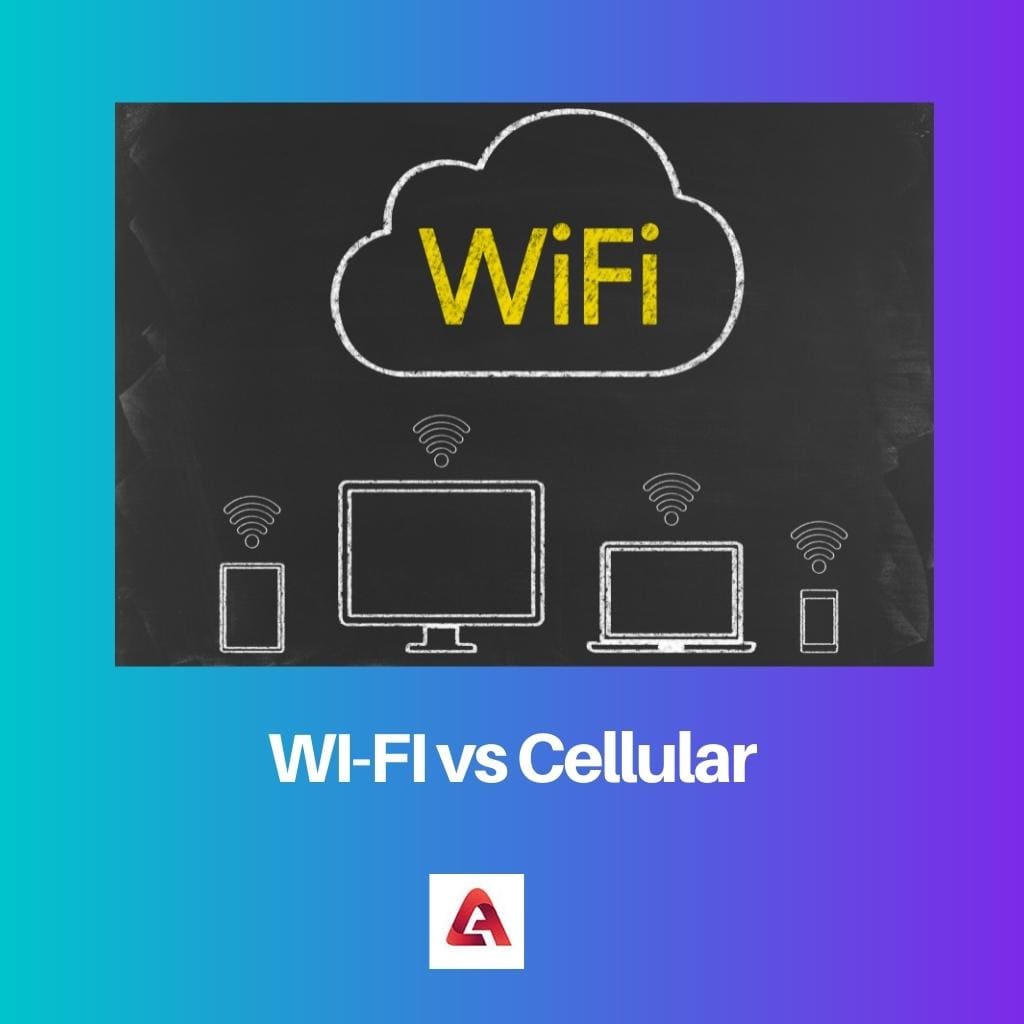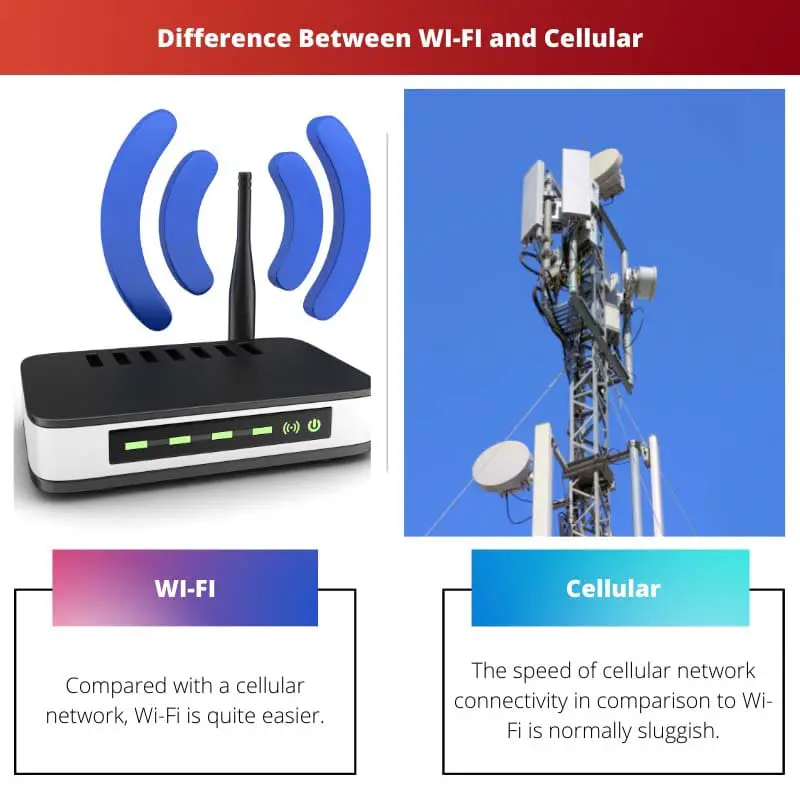For years, the word “Wi-Fi” has been used along with wireless Internet, be it your private home or free Wi-Fi hotspot, accessing cafés, highways, colleges, and so on, virtually wherever you go.
Wi-Fi is a networking technology that can link to the Internet or wirelessly interface with computers, laptops, smartphones, and other mobile devices in a specified range.
Comprising the best of two worlds and building on the capabilities provided by each technology, integrated Wi-fi and cellular are regarded due to the rapid use of wireless LAN networks in the home region, workplaces, and in other trade areas, wireless operators do not see wireless Internet as their rival technology.
Both technologies can be used for internet connectivity but are somewhat distinct.
Key Takeaways
- Wi-Fi is a wireless networking technology that uses radio waves to transmit data over short distances. At the same time, Cellular is a wireless communication technology that uses cellular networks to transmit voice and data over long distances.
- Wi-Fi can only be accessed in a limited range, within 100-300 feet from the router. In contrast, Cellular network coverage can be accessed almost anywhere, as long as there is a cellular signal.
- Wi-Fi is faster and more reliable than cellular data. Still, cellular data plans offer more flexibility in terms of mobility and availability, making them ideal for people who are constantly on the go.
WI-FI vs Cellular
Wi-Fi is a wireless technology that allows devices to connect to the internet and communicate with each other without the need for wires or cables. It uses radio waves to transmit data over short distances. Cellular refers to mobile network technology that allows mobile devices to connect to the internet using radio waves transmitted by cell towers. It enables wireless communication for voice, text, and data.

Wifi means wireless faithfulness. It is a wireless networking technology for the local region for IEEE 802.11-based applications. Wireless Internet-compatible computers are accessible through a Wi-Fi network and an AP-abbreviated Wireless Access Point.
Each WLAN has an entry point for receipt and transmission of data from/to users.
Cellular has a basic network analogous to 802.11 AP, which enables moving people to access the network, and there is an air bridge between the physical and layer protocol between the handset and the basic stations.
The network of cells spans a geographical area and a connecting layer. Both base stations are attached to the mobile switching centre connecting cells to the large network, and managing call installation and mobility.
Comparison Table
| Parameters of Comparison | Wi-Fi | Cellular |
|---|---|---|
| Speed | Compared with a cellular network, Wi-Fi is quite easier. | The speed of cellular network connectivity in comparison to Wi-Fi is normally sluggish. |
| Standard | Wi-Fi is the IEEE 802.11 standard wireless network infrastructure. | Cellular networks are built on a broad range of mobile telephones that use networks. |
| Data Plans | Wi-fi does not have any such limitations or plans to consume data. | Cellular applications have a schedule for the consumption of info. |
| Range | The wireless internet connection is limited. | Cellular networks rely on the availability of the spectrum of networks. |
| Internet Access | Wireless internet uses radiofrequency waves to give wired computers high-speed internet connectivity. | Cellular applications using mobile signals for connection to the internet are dependent on cell networks. |
What is Wi-Fi?
Have you ever liked to go and lounge and browse the Internet anywhere on the beach? Otherwise, add your e-mails to a wireless network in the cupboard or talk in a coffee shop with your friend. Both this stuff and more can be done with Wi-Fi.
Bring several machines together and wirelessly connect them – Wi-Fi is the only way.
Wireless Internet is a technology that uses radio waves to provide internet access and wireless intercommunication to mobile devices, including smartphones, laptops, and tablets.
Did you ever wonder how Wi-Fi systems interconnect? Ok, wi-fi technology is the easy solution. Signals are transmitted to different devices through radio waves.
The receiving equipment must be set to receive waves of a certain frequency. The frequency range for Wi-Fi is 2.4 GHz to 5 GHz. It is more popular than walkie-talkies, cell telephones, and TVs. This higher frequency spectrum allows for the transmission of signals with more detail.

What is Cellular?
Cellular networking technology uses short-distance radio stations for moving devices in environments, including cells and transceivers. Cellular has a common association with a mobile telephone system.
In recent years, the wireless industry has grown dramatically in terms of mobile technologies and subscribers.
A Cell network refers to a mobile network, and the idea is to reach large areas with high bandwidth. You use wireless access on your mobile phone service if you are not wired to a Wi-Fi network and still use your phone to connect to the Internet.
A cellular network is a networking network with a broadband connection to and from the terminal nodes.
The network is distributed by so-called ‘boxes’ of at least one fixed transceiver (three cell sites or base transceiver stations). These base stations have wireless network coverage and can be used for the transmission of audio, information, and other information.
A cell uses various frequencies from neighbouring cells to avoid interference and ensure guaranteed service safety.

Main Differences Between Wi-Fi and Cellular
- The computer with a cellular signal for connection to the internet is connected with the cellular plane, whereas Wi-Fi (with free connectivity to handheld networks with WI-FLAN) is a local networking infrastructure that uses radio waves.
- Cellular is a network spread across a broad region of a mobile network, whereas Wi-Fi internet is a key feature of the IEEE 802.11 standards and an important wireless networking infrastructure.
- Cellular phones have no spectrum limit, whereas there are few Wi-Fi connections.
- The technology used for cellular networking is mobile, whereas to broadcast and receive information, devices may use the Wi-Fi protocol.
- Cellular provides low-consumption data plans, whereas Wi-Fi has no cap on how much information a day or a month can access.
- In terms of speed and reliability, the cellular network is comparatively sluggish, whereas Wi-Fi is faster than mobile networks.

- https://www.mdpi.com/1999-5903/11/6/122
- https://ieeexplore.ieee.org/abstract/document/7875114/?casa_token=m0rsLuP3hoYAAAAA:KuGrGMJ4UM74di023AEQDwzyTLnAwLxdgxZ_DI3I88gQcPEKW4KGtxITX59hawQSRUrB1IuYSg

The explanation of Wi-Fi and Cellular networks in this article is exceptional. The author does an outstanding job of providing comprehensive and clear insights into both technologies.
I couldn’t agree more, this article is a great resource for understanding the differences between Wi-Fi and Cellular networks.
The article delves into the intricacies of Wi-Fi and Cellular networks in a very accessible manner. A great resource for learning about these technologies.
Definitely, the author’s comprehensive approach to explaining Wi-Fi and Cellular networks is commendable. Informative read!
The article offers a great overview of the history, technology, and application of both Wi-Fi and Cellular networks. It is written in a very accessible way and provides valuable insights into these important modern technologies.
I completely agree, the article presents a thorough and well-structured comparison of Wi-Fi and Cellular networks.
Indeed, the explanation is very clear and makes understanding the differences between these two technologies much easier. Great post!
The comparison table is very useful for visualizing the differences between Wi-Fi and Cellular networks. A great resource for those looking to understand these technologies.
Definitely agree, the article does an outstanding job of providing a comprehensive comparison of Wi-Fi and Cellular networks. A compelling read!
I found it extremely helpful as well, it really clarifies the distinctions between Wi-Fi and Cellular networks.
The article provides a highly detailed comparison between Wi-Fi and Cellular networks. A very comprehensive and informative read.
I completely agree, the author’s thorough explanation of Wi-Fi and Cellular networks is incredibly valuable for anyone interested in technology.
I found the comparison table especially helpful! It clearly outlines the differences between Wi-fi and Cellular networks.
I agree, the article offers a very thorough explanation of both technologies. It’s a great read!
The author does a good job of explaining the fundamental differences between Wi-Fi and Cellular networks. This is valuable information for anyone interested in technology.
Absolutely, the article provides a clear and detailed comparison that is very informative.
This is a fantastic explanation of Wi-Fi and Cellular networks. The author does a great job of breaking down complex technology into easy-to-understand concepts.
This article is an excellent resource for understanding Wi-Fi and Cellular networks. The author offers a thorough comparison that is both insightful and accessible.
Absolutely, the article’s detailed comparison provides valuable insights into Wi-Fi and Cellular networks. Highly informative!
The author’s detailed explanation of Wi-Fi and Cellular networks is very insightful. This article contains valuable information about these technologies.
I agree, the comparison is very thorough and well-explained. A great resource for clearing up any confusion about Wi-Fi and Cellular networks.
Absolutely, the article provides a highly informative overview of Wi-Fi and Cellular networks.